Related Research Articles

A prisoner of war (POW) is a person who is held captive by a belligerent power during or immediately after an armed conflict. The earliest recorded usage of the phrase "prisoner of war" dates back to 1610.

Algona is the county seat of Kossuth County, Iowa, United States. The population was 5,487 at the 2020 census. Ambrose A. Call State Park is located two miles southwest of the city.

Onawa is a city in, and the county seat of, Monona County, Iowa, United States. The population was 2,906 at the time of the 2020 Census. It is the largest town on the Iowa side of the Missouri River between Council Bluffs and Sioux City.

Hellfire Pass is the name of a railway cutting on the former Burma Railway in Thailand which was built with forced labour during the Second World War. More than 250,000 Southeast Asian civilians and 12,000 Allied soldiers built the railway line, including Hellfire Pass. The pass is noted for the harsh conditions and heavy loss of life suffered by its labourers during construction. It was called Hellfire Pass because the sight of emaciated prisoners labouring by burning torchlight resembled a scene from Hell.

Hart's War is a 2002 American war drama film about a World War II prisoner of war (POW) camp based on the novel by John Katzenbach. It stars Bruce Willis as Col. William McNamara and Colin Farrell as Lt. Thomas Hart. The film co-stars Terrence Howard, Cole Hauser, and Marcel Iureş. Directed by Gregory Hoblit, the film was shot at Barrandov Studios in Prague, and released on February 15, 2002. The film earned mixed reviews, grossing $33.1 million against its $70 million budget.
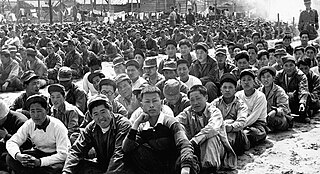
A prisoner-of-war camp is a site for the containment of enemy fighters captured as prisoners of war by a belligerent power in time of war.
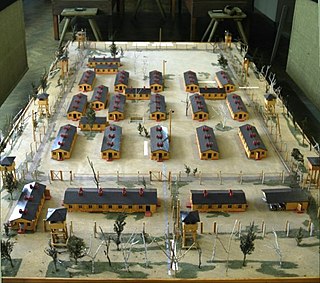
Stalag Luft III was a Luftwaffe-run prisoner-of-war (POW) camp during the Second World War, which held captured Western Allied air force personnel.

The Alamo Scouts was a reconnaissance unit of the Sixth United States Army in the Pacific Theater of Operations during World War II. The unit is best known for its role in liberating American prisoners of war (POWs) from the Japanese Cabanatuan POW camp near Cabanatuan, Nueva Ecija, Philippines in January 1945.
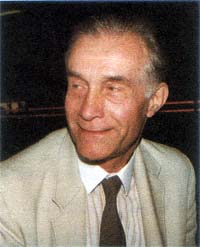
Stanley Warren was an English painter. He was a bombardier of the 15th Regiment of the Royal Regiment of Artillery who became known for the Changi Murals he painted at a chapel during his internment in Changi prison in Singapore during World War II.

Flandrau State Park is a state park of Minnesota, United States, on the Cottonwood River adjacent to the city of New Ulm. Initially called Cottonwood River State Park, it was renamed in 1945 to honor Charles Eugene Flandrau, a leading citizen of early Minnesota who commanded defenses during the Battles of New Ulm in the Dakota War of 1862. The park was originally developed in the 1930s as a job creation project to provide a recreational reservoir. However the dam was repeatedly damaged by floods and was removed in 1995.

Lieutenant General Albert Patton Clark was the sixth superintendent of the United States Air Force Academy near Colorado Springs, Colorado.

Lionel Colin Matthews, was an Australian Army officer in World War II. He was posthumously awarded the George Cross, the highest award for extraordinary acts of gallantry away from the field of battle that could be awarded to a member of the Australian armed forces at the time. Matthews was born in Adelaide, South Australia, and was schooled there before moving to Victoria. He trained as a signalman in the Royal Australian Naval Reserve before joining the Militia in April 1939. Commissioned as an officer in the Australian Corps of Signals, Matthews transferred to the 8th Division of the Second Australian Imperial Force after the outbreak of World War II.
Camp Beaver Dam was an American World War II prisoner of war camp in Beaver Dam, Wisconsin during the summer of 1944. The camp held 300 German prisoners of war in a tent city encampment where the Wayland Academy field house now stands.
The World War II Prisoner of War camp on the Gettysburg Battlefield was established on a former military engagement site of the American Civil War in Gettysburg, Pennsylvania in the United States.

Members of the German military were interned as prisoners of war in the United States during World War I and World War II. In all, 425,000 German prisoners lived in 700 camps throughout the United States during World War II.

The Pine Grove Furnace Prisoner of War Interrogation Camp was a secret World War II camp for interrogating German prisoners of war (POWs) located in a remote region in southern Pennsylvania, selected partly because of its proximity to Washington, DC. It operated from 1943 to 1945. Some ruins of the facility remain today.
Members of the United States armed forces were held as prisoners of war (POWs) in significant numbers during the Vietnam War from 1964 to 1973. Unlike U.S. service members captured in World War II and the Korean War, who were mostly enlisted troops, the overwhelming majority of Vietnam-era POWs were officers, most of them Navy, Air Force, and Marine Corps airmen; a relatively small number of Army enlisted personnel were also captured, as well as one enlisted Navy seaman, Petty Officer Doug Hegdahl, who fell overboard from a naval vessel. Most U.S. prisoners were captured and held in North Vietnam by the People's Army of Vietnam (PAVN); a much smaller number were captured in the south and held by the Việt Cộng (VC). A handful of U.S. civilians were also held captive during the war.
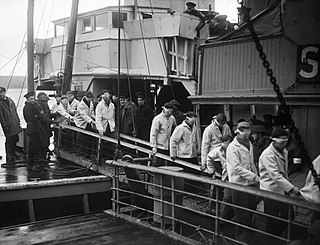
Large numbers of German prisoners of war were held in Britain between the outbreak of the Second World War in September 1939 and late 1948. Their numbers reached a peak of around 400,000 in 1946, and then began to fall when repatriation began. The experiences of these prisoners differed in certain important respects from those of captured German servicemen held by other nations. The treatment of the captives, though strict, was generally humane, and fewer prisoners died in British captivity than in other countries. The British government also introduced a programme of re-education, which was intended to demonstrate to the POWs the evils of the Nazi regime, while promoting the advantages of democracy. Some 25,000 German prisoners remained in the United Kingdom voluntarily after being released from prisoner of war status.
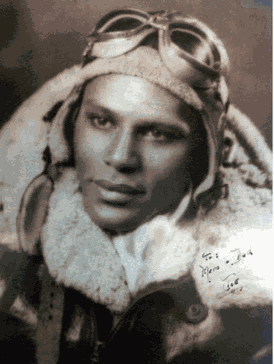
George Jewell Iles was a U.S. Army Air Force officer, former World War II Prisoner of War in Nazi Germany, and combat fighter pilot with the 332nd Fighter Group's 99th Fighter Squadron, best known as the all-African American Tuskegee Airmen.
References
- ↑ "AboutPW Camp Algona". PW Camp Algona. Retrieved 2024-03-18.
- ↑ "Behind barbed wire — Iowa's WWII POW camps, Part 1 of 2: Camp Algona housed 10,000 German and Italian prisoners -" . Retrieved 2024-03-18.
- ↑ "World War II Prisoners of War in Iowa | Iowa PBS". www.iowapbs.org. Retrieved 2024-03-18.
- ↑ "POWs in America: Camp Algona ExperiencePW Camp Algona". PW Camp Algona. Retrieved 2024-03-18.
- ↑ "ExhibitsPW Camp Algona". PW Camp Algona. Retrieved 2024-03-18.
- ↑ "An enduring symbol of peace: How World War II POWs built a nativity scene and goodwill -" . Retrieved 2024-03-18.
- ↑ Riley, Roger (November 17, 2021). "Iowa's own World War II Prisoner of War camp – the backdrop for new movie". WHO 13 . Des Moines, Iowa. Archived from the original on February 27, 2024. Retrieved July 22, 2024.
- ↑ "Silent Night in Algona". imdb . 2022. Archived from the original on December 27, 2022. Retrieved July 22, 2024.
- ↑ "Silent Night In Algona". Apple TV . 2022. Archived from the original on July 22, 2024. Retrieved July 22, 2024.
- ↑ "Silent Night In Algona". Rotten Tomatoes . December 9, 2022. Archived from the original on July 22, 2024. Retrieved July 22, 2024.